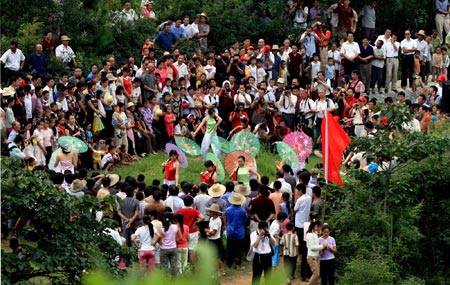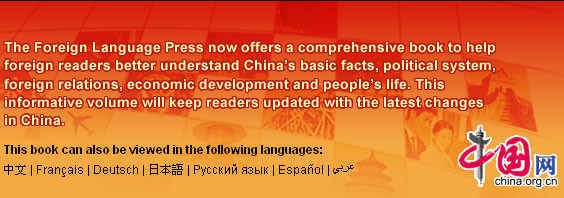In 2006, China pushed forward the reform of the cultural system in an all-round way and published detailed plans in this field for the next five years.
At the end of 2006, there were 2,766 performing troupes, 2,889 culture centers, 2,767 public libraries, 1,593 museums, 267 radio broadcasting stations, 296 television stations and 46 educational television stations throughout China. Subscribers to cable television programs numbered 138.62 million; and digital cable television services were offered in 209 cities, with 12.62 million subscribers. Radio and television broadcasting coverage rates were 95 percent and 96.2 percent, respectively. The country produced 330 feature films and 62 science, educational, documentary and cartoon movies in the year. A total of 41.6 billion copies of newspapers, 3 billion copies of magazines and 6.2 billion copies of books were published. At the end of the year, there were 3,994 archives in China and 63.55 million documents were made accessible to the public.
 |
A folk art troupe in Henan Province performs to farmers. China, with a vast territory, has rich and colorful folk cultures and arts.
Cultural System Reform
On January 12, 2006, the Central Committee of the Communist Party of China and the State Council jointly issued the Guidelines on Deepening Reform of the Cultural System, a directive document for the development of China's cultural undertakings and culture industry.
In accordance with it, for the first time, China allows culture units that have been transformed into enterprises to introduce non-public capital in the shareholding reform. It states explicitly that the transformation of state-owned culture units should be standardized and the ownership system reform should be accelerated, to realize the diversification of capital sources and improve the governance structure of corporate legal person. Qualified culture units will be allowed to go public after approval. Publishing houses, press agencies, and companies dealing in imports and exports of cultural products should remain state-owned or controlled after they have been transformed into enterprises. They can carry out franchised or licensed operations.
On September 13, 2006, the General Office of the Central Committee of the Communist Party of China and the General Office of the State Council jointly issued the Program for Cultural Development in the 11th Five-year Plan Period (2006-10). This is China's first middle- and long-term program focusing on cultural development, which contains guiding principles as well as objectives and tasks for the sector in the coming five years. It defines six priority areas--cultural development at grassroots level, key programs and projects for building up the national cultural image, establishment of the cultural industry, innovative capacity building, international cultural exchanges and personnel training.
Public Cultural Services
China launched the nationwide project of setting up rural grassroots libraries in 2006, and it is expected that by the end of 2010, 200,000 such libraries will have been built. As per the project, every library should be equipped with at least 1,000 books, 30 kinds of newspapers and magazines and some audio-video products. In 2006, more than 10 provinces and municipalities launched the project on a pilot basis, with more than 3,000 libraries being established.
By the end of 2006, 375 art galleries, 2,889 culture centers and 38,362 culture stations had been built. Besides, the year also witnessed the establishment of 6,700 entertainment service centers and stations at various levels. The goal of every county having at least one culture center and one library had been achieved.
In 2006, the government spent 50 million yuan on launching the "cultural wagon" project. The project is to provide grassroots culture institutions, such as performing troupes, with wheeled vehicle platforms, to serve rural residents. The input in upgrading public cultural establishments in poor areas made up 27.2 percent of the country's total investment in cultural undertakings in 2006.
Publication Sector Opening up Wider
China is gradually opening up its publication section to the outside world. It has already fulfilled its WTO membership commitment of opening two important areas of the publication sector: distribution and printing. At present, 38 foreign-funded distributors have been approved, with 14 granted wholesale rights. Wholly foreign-owned businesses, Sino-foreign joint ventures, and shareholding, private and state enterprises are all allowed to deal in the distribution of publications. As for printing enterprises, it is stipulated that Chinese partners should hold controlling stake in joint ventures engaged in publication printing. Except of this, foreign investors are allowed in printeries of all types. More than 2,000 joint ventures and wholly foreign–owned printing enterprises have been approved.
In book production, in line with current policies, foreign publishers are not allowed in editing, but cooperation on a case-by-case basis is permitted. Every year, foreign governments and publishers have considerable cooperation with Chinese publishing companies. All restrictions on copyright trade have been removed.
Chinese publishers have carried out copyright cooperation with their foreign counterparts in terms of production of newspapers, periodicals and audio-video products. Currently, 51 newspapers and periodicals have been published in China under this formula. Many fashion and computer magazines on sale are products of Sino-foreign copyright cooperation.
In September 2006, at the 13th Beijing International Book Fair, China exported 1,096 copyrights and imported 891. For the first time, exported copyrights outnumbered imported ones. At the Frankfurt Book Fair held in October 2006, the Chinese delegation exhibited more than 4,000 copies of books in 3,600 varieties. At the fair, 1,936 agreements on copyright exports and 1,254 agreements on imports were signed, with the former overtaking the latter for the first time.
International Cultural Exchanges
In 2006, China hosted the "Year of Russia," which featured more than 200 activities. On the Chinese side, over 500,000 people participated in the activities that drew an audience of dozens of millions. After more than 2,000 years of exchanges, China and India held the "Year of China-India Friendship" for the first time, with some 50 programs covering culture, politics, economy, trade, and science and technology. Dozens of activities under the "Year of Italy" program offered the Chinese public a window into Italian culture and lifestyle.
Initiatives such as the "Year of China" in Russia, "Spring of Sino-French Cultural Exchange," "China-Korea Exchange Year," "China-Japan Culture and Sports Exchange Year" and "Year of Spanish Culture" have been scheduled for 2007.
From February 2 to March 11, 2007, the Dream of Dunhuang concert performed by Lanzhou Song and Dance Troupe was well received by local audiences during its Spain tour. On January 9, 2007, The Changsheng Palace, a kunqu opera, was staged for the first time in Belgium. On January 10, 2007, a photo exhibition titled "Harmonious China: Pursuit and Dream" opened in Brussels, Belgium. On January 15, 2007, an exhibition of artifacts unearthed from Sanxingdui in southwest China's Sichuan Province was inaugurated in Singapore.






